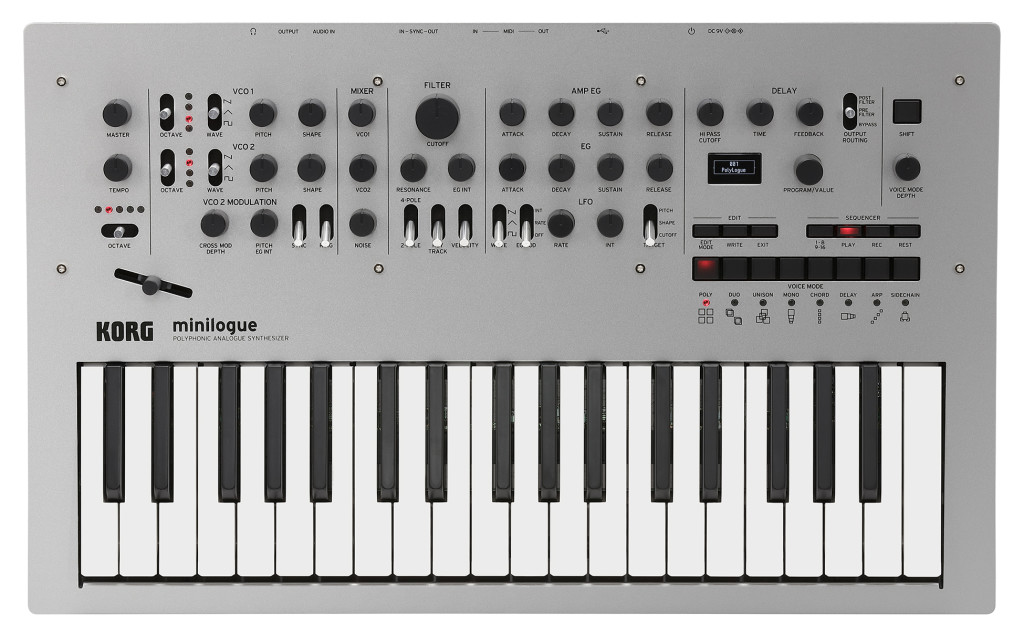Each year, the NAMM show serves as a second Christmas for musicians both in attendance and watching from afar. This year’s edition didn’t disappoint, with a wide array of innovative products being introduced. The synthesizer world saw many new intriguing models, with the growing Eurorack scene well represented.
Three NAMM 2016 synths piqued my interest, each for different reasons. None are priced higher than $500, so they share that feature in common. If you don’t have the budget to pick up one of the new Dave Smith/Tom Oberheim analog polysynths (the OB-6), Arturia MatrixBrute, or the Yamaha Montage, hopefully one of these designs does the trick.
Let’s check them out.
The Korg Minilogue offers Great Analog Sound on a Budget
Korg arguably won the price-performance ratio battle at NAMM 2016 with the debut of the minilogue. The new synth actually hit the street a few days before NAMM; surprising many with its polyphonic analog sound and deep feature set, all at a price under $500. Featuring a four-voice architecture, 16-step motion sequencer with Active Step, a cool oscilloscope display, and sync, the minilogue brings a lot to the table.
Here’s Korg chief engineer, Tatsuya Takahashi, giving an overview of the minilogue.
The 37-note keyboard suffers from mini-keys, but just use another keyboard as a controller if need be. An aluminum casing and a wood back panel give the synth a more robust feel.

When you consider the popular Volca series, it’s not surprising Korg was able to produce the minilogue at this price point. I use my Volca Bass and Keys together as a poor man’s analog polysynth, and they more than hold their own against the Moog Sub 37 and the quite evil Waldorf Streichfett. Still, Korg needs to be commended for the minilogue’s accessibility and robust feature set. Boom!
Korg brings FM Synthesis to the Volca Series
Takahashi-san — rapidly becoming this era’s synth engineer star ala Moog, Oberheim, or Smith — also introduced Korg’s upcoming Volca FM synth on the NAMM floor. Adding FM synthesis to the Volca series is a no-brainer, and the new synth is actually compatible with Yamaha DX7 patches using MIDI SysEx.
Here’s Tats demoing the new Volca, courtesy of the folks at Sonic State.
FM synthesis has long been known for its programming difficulty. I never enjoyed working with it until using a FM synth plug-in back in the halcyon days of Quarkspace’s Node in Peril album. The sonic possibilities of real-time parameter tweaking using this plug-in opened up a new world of sound far beyond the clichéd e-Piano patches for which FM is typically known.
The Volca FM provides this level of parameter control with the added benefit of motion sequencing. Since I’ve already invested in two Volcas (Keys and Bass), a Monotribe, and a SQ-1, the Volca FM will probably make an appearance in my studio. No news about a release date, but you can expect the street price to be around $159, the same cost as the other synths in the series.
Make Noise 0-Coast serves as the Gateway to Eurorack Modular
Make Noise continues to build a reputation as one of the bright lights in the growing Eurorack scene. While I’d love to invest in one of their Shared System kits, its price point is probably a bit too high considering my current budget constraints — replacing my music computer and audio interface remains paramount.
Thankfully, at this year’s NAMM the company introduced a desktop semi-modular synth called the 0-Coast (pronounced “no-coast”). The street price is slated to be $499 when the single voice synth hits the market later this year. The 0-Coast offers a taste of Make Noise’s innovative module collection, with a simplified parameter setup, and serves as a perfect entry point to the world of Eurorack.
Check out Music Radar talking with Make Noise’s Tony about the 0-Coast.
I’m considering purchasing a 0-Coast instead of the minilogue. Already owning a ton of Korg gear, as mentioned earlier, the Make Noise desktop synth offers the chance to visit new sonic vistas, and slowly dip the old toes into the Eurorack pool. The device should pair nicely with the SQ-1.
This look at three innovative, yet relatively inexpensive, NAMM 2016 synths hopefully offers hope for a new addition to your studio without breaking the family budget.


Pingback: Virtual Dispatches from NAMM 2017 | TabMuse -- a Home for Digital and Analog Music Inspiration
Pingback: The Best New Synths from NAMM 2018 | TabMuse -- a Home for Digital and Analog Music Inspiration